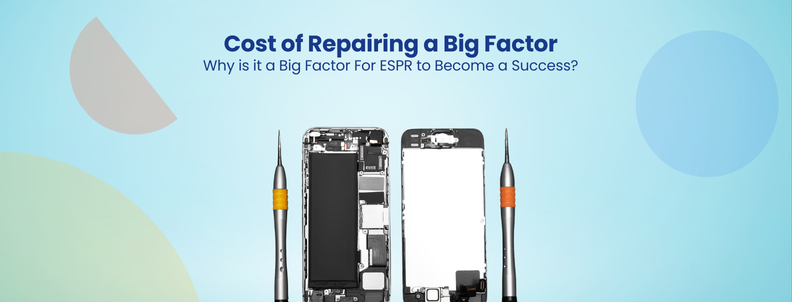Daily used products often break due to poor quality, planned obsolescence, or accidents. While many of us would love to repair these items or give them a second life, finding cost-effective solutions can be a significant challenge.
In many cases, the price of a replacement part can surpass the cost of purchasing a new product entirely. This is especially true for items like smartphones and various other electronic equipment.
The decision to repair or replace a product is largely influenced by cost. If repairing an item is more expensive than replacing it, consumers will likely opt for the latter, inadvertently contributing to increased waste.
Various studies on consumer behavior further prove this point.
Consumer Behaviour
A 2018 European Commission study on consumer behavior in the circular economy focused on common household items and clothing. It found that 64% of consumers usually choose to repair broken products, with 26% using professional services.
However, 36% of consumers, particularly in the Netherlands, did not pursue repairs, citing high costs and a preference for new products as the main reasons. Between 5% and 10% were unsure how to get repairs done, and 8% to 14% found it too demanding.
The study also demonstrated that repair decisions were heavily influenced by the cost of repair relative to replacement and the convenience involved. Consumers more attuned to the latest trends often opted for new purchases, while those valuing the circular economy were more repair-oriented.
A behavioral experiment revealed that consumers were willing to pay more for products that were easier to repair and highly valued for durability. When information on durability and reparability was provided at the point of purchase, products with higher reparability ratings were significantly more popular, underscoring a strong preference for sustainable options.
Decline in the Repair Industry
The repair industry faces ongoing challenges due to diminishing profitability, leading to declining repair businesses. This downward trend creates a cycle where consumers find it increasingly challenging to access repair services, potentially exacerbating the problem.
A 2016 European Parliament study on product longevity highlights this issue, providing concrete examples from two EU member states. The number of specialized electronics repair firms significantly reduced in the Netherlands, falling from 4,500 to 2,500 over a decade. Similarly, Poland experienced a 16% decrease in such businesses between 2008 and 2010.
Not just in the EU, the U.S. Census Bureau data reveals a significant decline in the consumer electronics repair and maintenance sector (NAICS code 8112111). The number of new firms established annually in this industry dropped from 4,623 in 1998 to 2,072 in 2015, indicating a substantial contraction over 17 years.
A study by Wei et al. highlighted labor challenges in China’s remanufacturing industry. Despite China’s reputation for affordable labor, half of the surveyed car remanufacturers reported difficulty recruiting skilled technicians at competitive wages. This finding suggests a growing scarcity of workers with technical expertise and affordability, potentially impacting the industry’s growth and competitiveness.
Impact of Increased Repair
Increasing product repair can have significant and multifaceted impacts across various environmental, economic, and social domains. Here are some key impacts:
1. Environmental Benefits
Reduction in Waste: By extending the lifespan of products through repair, we can significantly reduce the amount of waste generated. This is particularly important in addressing the growing issue of electronic waste, which poses substantial environmental and health risks. (Source)
Conservation of Resources: Repairing products means fewer new products must be manufactured, raw materials must be conserved, and energy consumption associated with production must be reduced. This contributes to a decrease in greenhouse gas emissions and other pollutants.
2. Economic Implications
Cost Savings for Consumers: Repairing products can be more cost-effective than purchasing new ones. This can increase consumer savings, especially for high-value items like electronics.
Job Creation in Repair Industries: As demand for repair services increases, there will likely be a growth in jobs related to repair and maintenance. This can revitalize local economies and create new business opportunities.
3. Social Changes
Shift in Consumer Attitudes: Increasing product repair can foster a cultural shift towards valuing durability and sustainability over disposability. This change can encourage consumers to prioritize products that are designed for repairability.
Empowerment through Skills: As more people repair their products, there is potential for skill development and empowerment. This can lead to consumers’ greater sense of agency regarding their possessions. (Source)
ESPR: A Solution to Make Repair Success?
Extending the life of products is crucial for sustainability. A product’s longevity hinges on two main factors: its durability and ease of repair. Durability determines how long a product lasts before failure, while repairability depends on its design. For example, the assembly process can determine how easily and affordably a product can be repaired.
The most commonly damaged components in smartphones are the screen and battery. Yet many models are designed to make accessing these parts difficult without dismantling the entire device.
The core purpose of the Ecodesign for Sustainable Products Regulation (ESPR) is to address these issues. This new set of measures aims to make products more sustainable by establishing specific design requirements. The regulation affects nearly every product, with exceptions for food and medicine. Any international manufacturer wishing to do business within the EU, including online sales, must comply with these standards or face penalties from member states.
A pivotal aspect of the ESP is the Digital Product Passport, which provides detailed information about a product’s journey, including the origin of materials and how easy it is to repair or recycle. This initiative empowers consumers with reliable information about product lifespan, guarantees, and environmental performance, promoting durable, repairable, and energy-efficient goods.
The ESP is framework legislation, meaning specific rules will be progressively established for different products or groups. Priority may be given to furniture, detergents, textiles, and electronics. Additionally, the regulation will ban the destruction of unsold textiles and footwear, targeting large and medium-sized enterprises.
Conclusion
The ESP regulation requires companies to adopt a more sustainable and circular business model. For Europe, extending product lifetimes could reduce dependence on specific materials and create more jobs in sectors like repair services. However, the success of the ESP will depend on its implementation and the criteria set for new products.
Making sustainable choices is increasingly popular among consumers, but affordability remains a significant challenge. The key issue lies in externalities—negative effects not included in the product price. The individual benefits from lower prices, but society bears the cost. With these new measures, the EU aims to double its use of recycled materials and achieve its energy targets by 2030, pushing for a more sustainable future.
Authored by: Vipin Singh, Market Research, and Mayank Maloo, Solutions.









